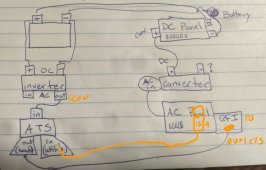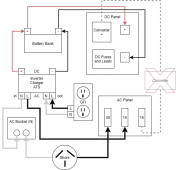I don't see a diagram. Still in progress?Thanks for your response. I drew a diagram of what I think you're suggesting. Can you take a look and tell me if that's right?
A couple additional questions
- How does the ATS stop power from coming from the batteries when I'm hooked to shore power. I thought the shore power needed to run through the ATS to cause it to switch. I suppose power might be coming back from the GFI line... is that it?
- Do the inverter AC-in or the converter negative (assuming that exists) need to connect to anything?
There are two inputs to the ATS. One input is from the branch circuit breaker. When shore power is available the transfer switch will pass through the shore power. The second input is from the inverter. If there is no shore power the inverter power will feed to the single branch circuit.
OK so an ATS has a normally closed side and I would connect that to the inverter. The normally open side Goes to the branch circuit breaker. The relay will then switch when shore power is present and disconnect the inverter. The normally open side is often called the generator side. Or of course you can just turn the inverter off.
There is no inverter in for what I describe. If the inverter has an in & out then it has an internal transfer switch. This can work also but these are often larger inverters. My description is primarily for a smaller stand alone inverter. The existing converter can continue to be used to charge the battery.





